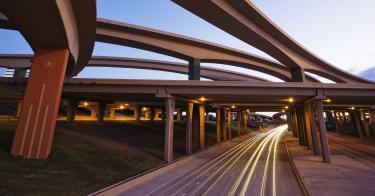Divided government often results in gridlock, and we’re likely to see more of that over the next two years. The House majority will be razor-thin, and control of the Senate will be decided by runoff elections in Georgia on Jan. 5.
Perhaps because the two parties are so deeply divided on most policy areas, the few less-politicized issues stand out. Historically, one of those issues has been infrastructure. Legislation in this area often passes with overwhelming, bipartisan majorities. However, it is now becoming difficult to find common ground even on infrastructure.
A significant reason for this is that many high-profile leftists have roped the issue into an aggressive “Green New Deal” agenda. They seek to use massive taxpayer subsidies to push people from private cars into mass transit.
Yet the federal government has tried to pack people into trains since the days of disco, and has little to show for it. That’s because America is less densely populated than transit-oriented parts of the world such as Japan and Western Europe, something that will not change for the foreseeable future.
About 30% of the federal Highway Trust Fund already is diverted to pay for non-highway uses such as mass transit, bike paths, and even ferry-boat terminals. This is unfair to hard-working families who pay into the fund through the federal gas tax.
Worse, the extra spending has caused the trust fund to run massive deficits, leading to debt-fueled bailouts. That’s unfair to future generations.
Right now, federal infrastructure policy tries to do everything for everyone. As a result, nobody is happy. We need a better approach, preferably one that doesn’t try to govern Manhattan, New York, and Manhattan, Kansas, the same way.
First, the federal government should stop taking money from people using high-demand infrastructure to subsidize low-demand infrastructure. This practice extends from the highway fund to airports to harbors.
In each case, money is spread around as broadly as possible so that more politicians can say they brought home the bacon. Unfortunately, this leads to many bad investments, since vital infrastructure isn’t evenly distributed across the country.
Rather than treating infrastructure spending as a political slush fund, federal legislators should focus entirely on items of true national significance such as the interstate highway system.
Second, the federal government should stop micromanaging project details. While federal funds can help grease the wheels for infrastructure in a metaphorical and literal sense, the cost is steep.
To qualify for federal funding, projects are swaddled in red tape. Rules such as the Davis-Bacon Act and project labor agreements undermine non-unionized firms and increase costs, which has an oversized impact in right-to-work states.
Federal agencies also dictate how much is spent on different types of transportation. For example, a set amount of highway trust-fund dollars must be spent on transit, even in states such as Wyoming where those needs are minimal.
Instead of dictating how infrastructure dollars are spent, the federal government should step back and allow decision-making to take place at a more local level, which is where most infrastructure is built and maintained.
Finally, the federal government should get out of the way of state and local governments and the private sector when it comes to raising funds for infrastructure. This would mean reforming limits on highway tolls, removing limits on airport user fees, and no longer providing preferential tax treatment to municipal bonds over private infrastructure bonds.
If non-federal actors could raise funds more easily, they would be less reliant on Washington, which would keep decision-making closer to home and speed up the approval process.
A Congress with narrow majorities can’t possibly agree on a sweeping infrastructure agenda. We would be much better off if they went the opposite direction and let states and regions with different needs and preferences can makes the choices that are right for them.
This piece originally appeared in the Washington Times



